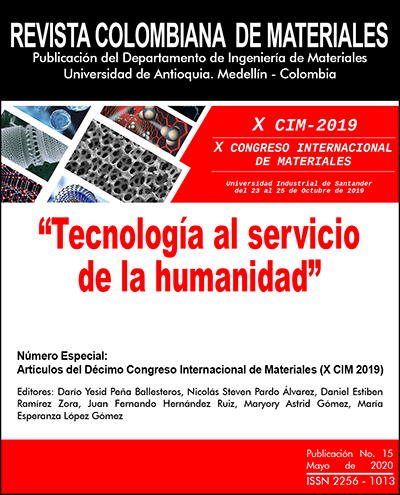Estudio de la evolución microestructural del acero AISI A2 sometido a tratamientos isotérmicos de austemperado y Q&P
DOI:
https://doi.org/10.17533/udea.rcm.342066Palabras clave:
aceros de herramienta, bainita, austemperado, quenching & partitioningResumen
El acero AISI A2 es ampliamente utilizado en aplicaciones de deformación en frío, donde debido al contenido de elementos aleantes, después de templado y revenido presenta una microestructura martensítica rica en carburos que le confieren una muy buena resistencia al desgaste. Poder conservar esta resistencia al desgaste y al mismo tiempo mejorar la tenacidad a la fractura, es el escenario ideal para estos materiales, principalmente en aplicaciones donde la deformación en frío se genera por impacto. Con la aplicación de tratamientos isotérmicos de baja temperatura como el Austemperado y el Quenching and Partitioning (Q&P) se busca la obtención de microestructuras más tenaces y de igual resistencia. Para evaluar la respuesta microestructural del acero AISI A2 a estos tratamientos isotérmicos, se determinó una temperatura de austenización de 950 ºC, para conservar tamaño de grano austenítico y de carburos primarios en un nivel adecuado. Posteriormente se realizaron tratamientos de austemperado a 300 ºC durante 1, 2 y 3 horas y de Q&P, en los cuales se realizó enfriamiento en baño de sales hasta 170 ºC y 150 ºC, con sostenimiento durante 5 minutos, para luego llevarlos a 300 ºC en baño de sales, durante 1, 2 y 3 horas. Se realizó la caracterización microestructural mediante microscopía óptica (MO), microscopía electrónica de barrido (MEB) y difracción de rayos X (DRX). Se hicieron mediciones de dureza. Los resultados fueron comparados con los obtenidos en tratamiento de temple y revenido convencional.
Descargas
Citas
Roberts G, Krauss G, and Kennedy R. Tool Steels 5th edition. ASM Handbook. ASM International. 1998; 121.
Gao, G., Zhang, H., Gui, X., et al., “Enhanced ductility and toughness in an ultrahigh-strength Mn – Si – Cr – C steel : The great potential of ultrafine filmy retained austenite”, Acta Materialia, 76, 425–433, 2014.
Krauss G. Steels: Processing, structure and performance, ASM International, 2005.
Vatavuk, J., Totten, G. E., Nucci, J. E., et al., “Comparative Impact Behavior of High-C Steel After Conventional Quenching, Tempering, and Austempering”, Materials Performance and Characterization, 5(1), 2016.
Santigopal S., Pinaki B., Sushil G.,et al., “Formation of Bainite Below the Ms Temperature: Kinetics and Crystallography”, Acta Materialia 105. P 390-403, 2016.
Speer J.G. “Phase Transformation in quenched and partitioning steels” in: Phase transformation in steels vol 2. Cap 9 . Woodhead Publishing Limited, p 247-270, 2012.
Mattavelli D., Cislaghi L., Rosso M., et al., “Austempering effect on structure properties and performance of hot-work tool steel”, Journal of microstructure and material properties Vol 3, 2008.
Celada-Casero C., Kwakernaak C., Sietsma J., et al., “The influence of the austenite grain size on the microstructural development during quenching and partitioning processing of a low-carbon steel”, Materials and Design 178, 2019.
Chen S., Wang G., Liu C., et al., “Correlation of Isotermal Bainite Transformation and Austenite Stability in Q&P Steels”, Journal of Iron and Steel Research 24, 2017.
Koistinen D.P, Marburger R.E. A general equation prescribing the extent of the austenite-martensite transformation in pure iron-carbon alloys and plain carbon steels. Acta Metallurgica. 1959, 7, 59–60.
Smanio, V., Sourmail, T. “Effect of partial martensite transformation on bainite reaction kinetics in different 1% steels”. Solid State Phenom., vol. 172–174, pp. 821–826, 2011.
Van Bohemen, S.; Santofimia, M.; Sietsma, J. “Experimental evidence for bainite formation below Ms in Fe-0.66C”. Scr. Mater., vol. 58, pp. 488–491, 2008.
Samanta, S.; Biswas, P.; Giri, S.; Brat, S.; Kundu, S. “Formation of bainite below the Ms temperature: Kinetics and crystallography. Acta Mater., vol. 105, pp. 390–403, 2016.
Descargas
Publicado
Cómo citar
Número
Sección
Licencia
Derechos de autor 2020 Revista Colombiana de Materiales

Esta obra está bajo una licencia internacional Creative Commons Atribución-NoComercial-CompartirIgual 4.0.








